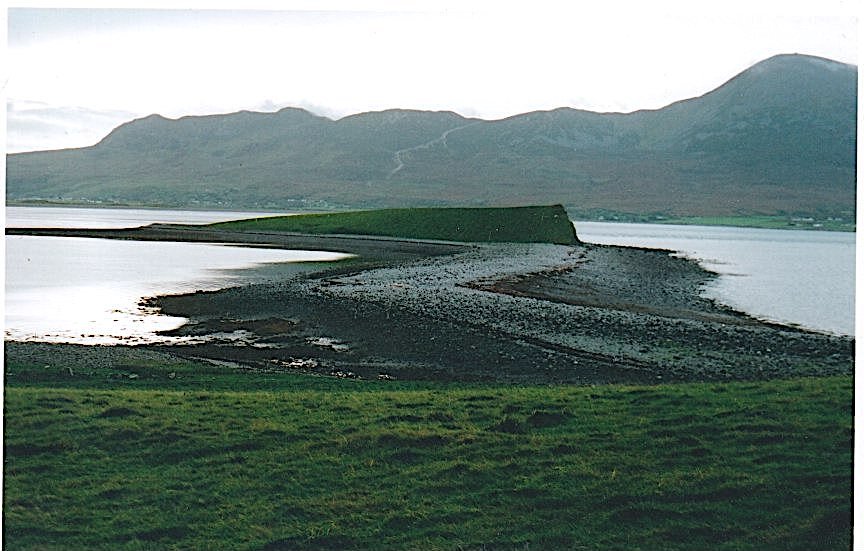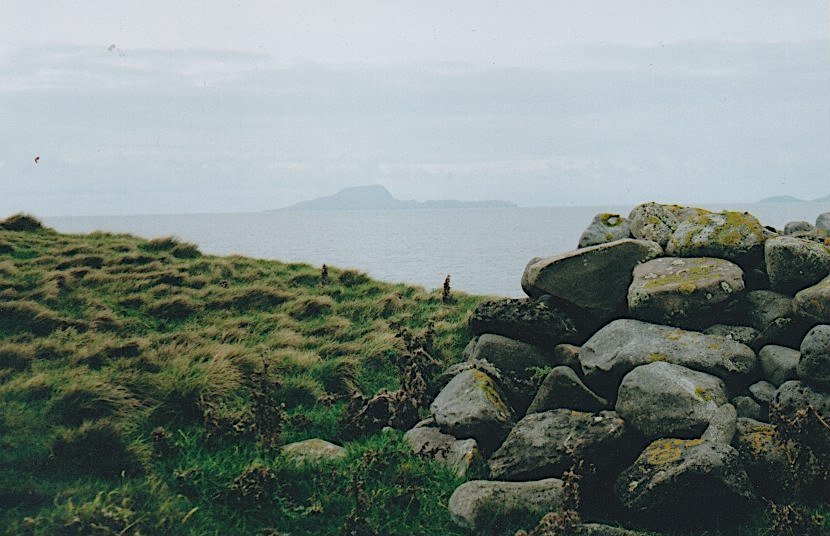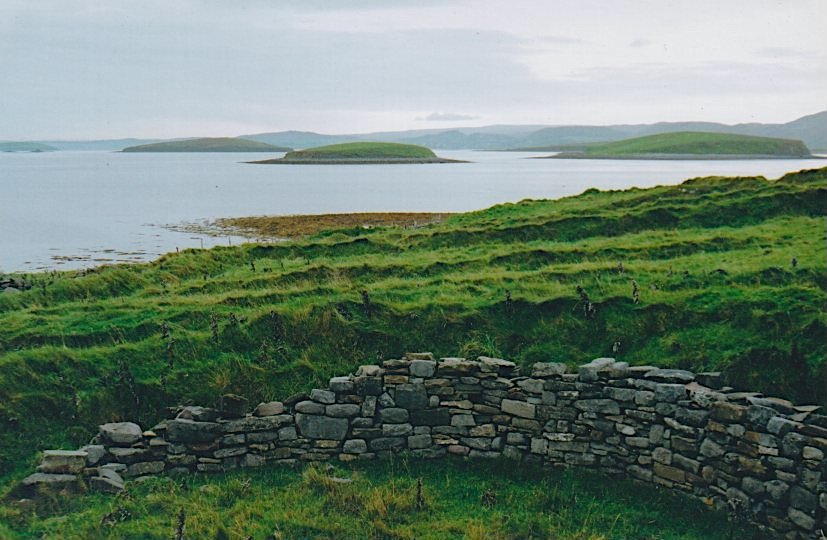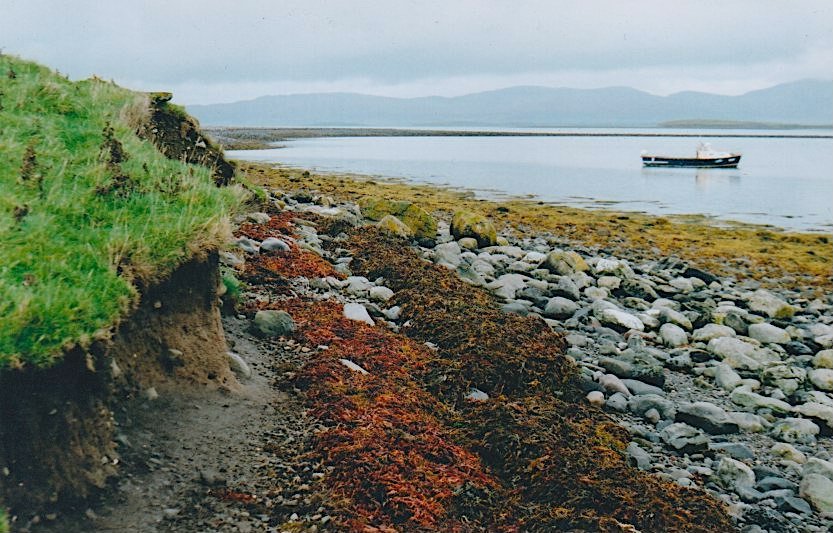
The story of John Lennon and ‘Beatle Island’
The musician once planned to build a home on Dorinish, an uninhabited island in County Mayo, Ireland
It all started with an acid trip. Well, it was 1967, the year The Beatles recorded their psychedelic album Sgt. Pepper’s Lonely Hearts Club Band. John Lennon had been ‘drinking tea’ with his friend, gallery owner John Dunbar, on the last day of April and decided to head out to 14-Hour Technicolor Dream, the UK’s first major psychedelic ‘happening’, at North London’s hilltop Alexandra Palace. Yoko Ono was there. She and John were only acquaintances then. Yoko was managing a performance of her discomfiting Cut Piece, in which the audience was invited to snip off a young woman’s clothes with amplified scissors announcing every snip. And Pink Floyd played as the sun came up and light flooded into the palace.
Later that morning, back at the Surrey mansion he shared with his wife Cynthia and son Julian and continuing to take LSD, the two Johns chanced on a newspaper advertisement for an island for sale off the west coast of Ireland. To be sold by public auction: 19-acre Dorinish, one of 300-plus islands that sit in County Mayo’s peaceful Clew Bay. Lennon decided to buy it there and the pair set off on an acid-fuelled Irish jaunt to seal the deal.
Or at least, this is the version of the story that appears in Philip Norman’s John Lennon: The Life and was first told by John Dunbar. However, it is only partially true. The alternative - and most accurate - account is that of Alistair Taylor, an assistant of Brian Epstein and The Beatles’ ‘Mr Fixit’ for holidays, travel and big purchases, who says he had been asked by John to find a tranquil island within two hours of London for him, Cynthia and four-year-old Julian. Having spotted the newspaper ad and got details and photos of the Irish island and its upcoming auction, Alistair called at Weybridge to discuss it with John, who was instantly enthusiastic and told him: “That’s it! I’ve got to have it!”
Either way, the 26-year-old millionaire made an instant decision to buy an Irish island. Why? All of The Beatles were struggling to deal with worldwide fame and had discussed buying a Greek island or four together. Although John loved the idea of experimenting with communal living, the deal was proving tricky. Paul had already snapped up High Park farm in Kintyre, Scotland, so the precedent for creating distance from the Beatles ‘scene’ was set. John had sufficient Irish genes (his paternal grandfather was from Dublin) for them to signify in a search for identity and peace. An Irish idyll might provide his perfect solution.
He dispatched Alistair to bid discreetly against local farmers keen to use the island for stock grazing and as a source of useful rocks. They were successfully outbid, and Alistair secured it for £1,550 (the equivalent of about 37,000 Euros today).
I

Soon afterwards came the night at Ally Pally, followed by a brief discreet visit to Mayo by John, Alistair and John Dunbar. John was thrilled with what he saw. He quickly returned armed with an entourage and plans for the island. In what was then a very traditional Ireland - the im/morality of the mini skirt was a subject of much debate - his appearance caused a stir. Paddy Quinn, who took the group out to Dorinish in his boat, remembers that his dog took great exception to John’s long Afghan coat. Most of the entourage were professionals - architect, solicitor and accountant - calculating how to make the project work, but also present was ‘Magic’ Alex Mardas, a kaftan-wearing Apple employee whose outlandish inventions delighted The Beatles. He suggested that John should build a ‘bubble house’ that would somehow float over the island. However, after the visit John applied for planning permission for a traditional building and, while he was waiting for that to go through, arranged for a vibrantly painted showman’s caravan to be rafted over to the island.
Cynthia Lennon wrote about the colourful caravan in her autobiography A Twist of Lennon., explaining that John bought it for their garden and had his Rolls-Royce decorated in the same style. She remembers it as a symbol of the volcanic creativity that erupted from his drug use and the contemporary scene. She doesn’t mention Dorinish at all, which is unsurprising given that her six-year marriage ended before she had the chance to visit it. Instead, it was Yoko Ono who accompanied John on his return trip to Mayo the following month, late June 1968.

I visited Dorinish in 2005, and took the photographs on this page from the island. It hadn’t been much written about then - I’d come across the subject in an online discussion between two Beatles fans - and I suggested a feature on ‘John Lennon’s island in Ireland’ to The Telegraph to mark the 25th anniversary of his death. They were enthusiastic. I flew to Knock then drove 60 miles north up the coast to Westport, passing “seaweed-freckled Louisburgh and a forbidding Crough Patrick mountain decapitated by mist”. Tourism Ireland market it as part of the Wild Atlantic Way now, and it’s a beautiful journey.
Westport was an attractive town where sunshine bounced off magenta and mustard houses that flowed out from a central clock tower. Fishmongers and wool shops mingled with bistros and art galleries, and a poster in a pub window advertised traditional music sessions for the coming week. Tourism Ireland had kindly invited me to spend a couple of nights at the Great Southern Hotel, where John and Yoko had stayed (the caravan not being up to scratch as accommodation). In a happy coincidence, the hotel had just been refurbished and was advertising the couple’s room as the John Lennon Suite (it’s now bookable as the Mulranny Park Hotel; John Lennon Deluxe Room). It wasn’t a grand hotel, but it was ‘grand’ in the Irish sense, being a large, welcoming 19th-century building with a perfect view over the northern curve of Clew Bay. The room that John and Yoko slept in had a sloping ceiling and was decorated in retro coffee-and-cream colours with a few photographs of the couple - nothing over the top and very cosy.
What Beatles fan wouldn’t love a time machine to transport them back to see the scenes during the three days John and Yoko spent at the hotel? On the second night the owners laid on traditional Irish music and dancing. Yoko borrowed some flat shoes so she could join in. John reciprocated by playing a pre-release tape of Revolution, The Beatles’ ‘statement’ about anti-Vietnam War protests that were kicking off that year.
After breakfast on my first morning, I headed to Westport‘s Rosmoney pier to meet Tommy Gibbons who, as a child, had gazed at the sky as John and Yoko’s's helicopter flew over his family's island. He now took visitors out to the bay to fish for mackerel and was transporting me to Dorinish. We wove past various small, earthy isles on the boat journey. More specifically, they are sunken drumlins: hills of sediment shaped by glacial activity. While seal colonies formed the area’s largest population, not all of the islands were deserted. Tommy pointed out one owned by a group of transcendental meditationists and told me, "It's interesting to see who turns up here."
In 20 minutes we were at Dorinish, which had a quirky, varied appearance. In the article I said it resembled “a velvety emerald burial mound, edged by boulder beach. At each side, a stone reef stretches out into the bay, one pointing at Inishgort lighthouse, the other linking to a second piece of land shaped like an upturned iron.”
When the boat's motor cut out there was total silence. The air was sweet, the peace was tangible. But actually, it didn’t feel isolated. Neighbouring islands were close enough to hold a hollered conversation. With a decent pair of binoculars your every move could be observed from any of them. The mainland was still very much in sight. And anybody could rock up on a boat and walk straight on to the seaweed-ribboned shore.

What did Yoko make of it, I wondered. No doubt she saw the impracticalities. But did the idea even appeal to her in principle? That night I met up for a drink with Donie Quirke, who was fishing off Dorinish when John and Yoko visited. He told me the impression that stuck in his mind was watching the couple and observing the contrast in their body language. John sat cross-legged at the top of the island above ruins of shelters built for marine pilots, gazing out over the glassy bay and looking entirely at peace. Yoko - dressed all in black including the shortest skirt he’d ever seen - was much less comfortable. She stood on the shoreline. Nesting terns were dive-bombing her and she started flapping her arms, creating a silhouette show of total panic. The memory still made him laugh.
The couple’s helicopter also landed on Achill Island for a visit. This is Ireland’s largest island, with a population of 2,500-ish and a history of attracting artists and creatives. Graham Greene had visited often and written two novels here; American artist Robert Henri had found inspiration on its west coast. John and Yoko joined up with Jaws actor Robert Shaw for a stroll and a drink at The Amethyst Hotel, now The Amethyst Bar. Shaw had bought a home in the lough-side town of Tourmakeady so no doubt was full of praise for the area. I drove on to the island on my second day in Mayo - it’s connected to the mainland via a swing bridge - and immediately fell for Its villages of whitewashed cottages and blowy sea-bashed cliffs. A private property here could have been a perfect option surely - the companion hideway to Paul McCartney’s Mull of Kintyre - together with Dorinish for meditative visits?

Driving to Achill Island
But John never returned to Dorinish and he didn’t built on the island. Instead, he gave permission for a hippy commune to live there. Their ‘high priest’ was Sid Rawle, the hulking bearded instigator of Stonehenge’s summer solstice celebrations. He set up a tented camp for about 20 people in the hope of creating a “peaceful, loving community” without “cars and televisions and families and personal hoo-ha and damn you Jack, I’m all right”. The plan was to grow vegetables and trade in crab and lobster. But with no real shelter from Atlantic storms and quite some opposition from locals, living on the island was tough going. Most quickly moved on, though a small handful of diehards survived through winter before decamping.
In 1971, John moved with Yoko to New York, her old stamping ground, and lived there until 8 December 1980, when he was murdered outside his Manhattan apartment building. Yet he had kept hold of Dorinish as something of a pipe dream. When, soon after leaving the Beatles, he was asked in an interview with Jann Wenner for Rolling Stone magazine about plans for his and Yoko’s old age, he’d replied, “I hope we’re a nice old couple, living off the coast of Ireland or something like that - looking at our scrapbook of madness.” And just a few months before his death, he instructed his solicitor to revisit the lapsed planning permission to build on the island.
Although Yoko spoke about Dorinish, once reminiscing, “We often discussed the idea of building a cottage there… it seemed a perfect place to get away from it all," she had no personal plans for the island. Four years after John’s death she sold it, giving the proceeds to a Dublin children’s hospital. Finally, two farmers got hold of the island to graze their sheep there.
The idea that, had John Lennon lived, he and Yoko would have lived on Dorinish as some kind of retirement home may be wishful thinking - but it’s not infeasible that he might have built a house there. In his final year, he discovered the thrill of sailing, and bought a yacht, which could have brought him back to Dorinish’s shores. Either way, it’s certainly true that John planned to retain the island, keeping Clew Bay island’s beauty and tranquillity as part of his identity and life story. Which makes its place in Beatles history well deserved.
All Irish photos are the property of A Trip Up My Sleeve. Photo of John on the Home page: Joost Evers/Anefo via Wikimedia Commons



